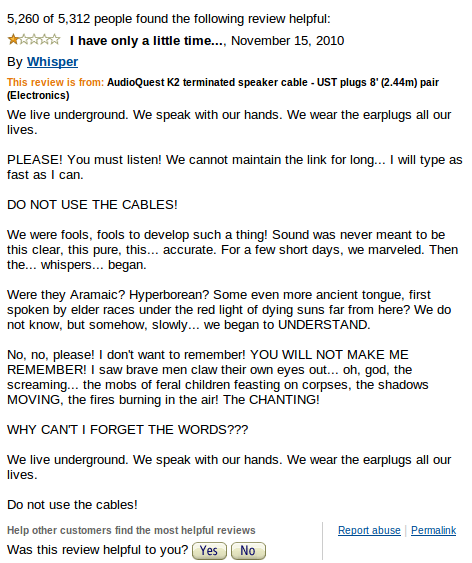Why can't I forget the words???
« previous post | next post »
Unlike the fly-genetics text for $23,698,655.93 (plus $3.99 shipping) and other amusing by-products of algorithmic trading run amok, this amazon.com page features a real price that some people apparently pay for a real product:

AudioQuest's web site will explain to you at length about the K2's "extremely high purity Solid Perfect-Surface Silver (PSS) conductors", patented "Dialectric Bias System", "dual-spiral construction" with "4-cross geometry", and "partially conductive carbon-loaded polyethylene" insulation, so that "a combination of these major ingredients, and many more subtle details add up to explain how even a reasonably priced cable like K2 can sound so good".
(Note that "even reasonably priced" is not a misprint.)
But about a year ago, some of amazon's customers began submitting critical reviews of this product, for example:
I have mixed feelings about these cables. Yes, they have unprecedented clarity and range, but they are silver, which is chock full of small hadrons. If, like me, you are an audiophile particle physicist, you'll know that small hadrons degrade the transmission of audio signals by decohering individual notes, particularly quarter tones that have been reflected off of acoustic surfaces. Additionally, the quality of silences is tranquil, but not peaceful; Philip Glass's note-free "4'33" fails to achieve the the subtlety of a live performance. […]
The REALLY good news is that the Large Hadron Collider (LHC) is up and running again. They're making anti-hydrogen right now, but the long-term goals are anti-copper and then anti-silver. Once they are able to create these antimatter elements and keep them stable for more than a few microseconds, we'll finally be able to get cables with large hadrons and few, if any, small hadrons. Not only will these cables transmit quarter tones accurately, but the large hadrons will ensure sonic accuracy of silence by properly managing the strange and top quarks on the electromagnetic signal.
But the single "most helpful" (and also most troubling) customer review was this one:
See "It was the linguists", 2/28/2008, for another short but poignant example of the "Sapir-Whorf horror" genre.
There are also some nice Customer Images for this product. My favorite:

We built it with science
More on the parsing of "large hadron collider" is here.
[Tip of the hat to uhpinions.com]

iching said,
September 4, 2011 @ 9:49 am
What a hoot! I have a CD laying (sic – it's my idiolect) around somewhere with 16 versions of *John Cage's* 4'33", all quite different.
[(myl) Given the 74-minute standard capacity of audio CD-Rs, the stack of blank CD-Rs on my desk can each be said to contain 16 versions of this piece, with a minute and 12 seconds left over for inter-track gaps, or perhaps for an extra performance of the first movement. Perhaps these are the same versions as on your disc? I've never noticed consistent differences among these implicit performances, perhaps due to an excess of small hadrons in my playback apparatus.
Of course, CD-RWs have an 80-minute capacity — as do many CD-Rs — so each of those contains 17 sull performances, with 2'39" left over. ]
Jeff DeMarco said,
September 4, 2011 @ 9:58 am
4' 33" is by John Cage, not Philip Glass
[(myl) Indeed. Also, "small hadrons" don't "decohere individual notes … that have been reflected off acoustic surfaces". Antimatter also contains small hadrons. And Hyperborean is mythical, but Aramaic isn't.]
Emily said,
September 4, 2011 @ 11:01 am
Deja vu– or the result of small hadrons going back in time?: http://www.amazon.com/Denon-AKDL1-Dedicated-Link-Cable/dp/B000I1X6PM
I also like the list of "attributes" for this one.
Sili said,
September 4, 2011 @ 11:09 am
I'm starting to understand why they don't dare put up these cables against the might of James Randi and his Million Dollars.
unekdoud said,
September 4, 2011 @ 11:15 am
Well, I believe the most famous product reviews of this type are those for "Tuscan Whole Milk, 1 Gallon, 128 fl oz" which has reached meme levels. The top review there is just hilarious.
There are many other products with funny Amazon reviews, but this has literature spoofs.
[(myl) In my opinion, the funniest thing about the Tuscan Milk item is the price: from $49.99 ("Milk will be bought and shipped the day you buy. Whether it not gets there fresh is not my problem.") to $10,000 ("Hand delivered by a real Tusken (Tuscan) cattle herdsman. … Dust cover missing. Some scratches on front, but contents are scratch free.") In fact, it seems that not only the reviews but also the product offerings are a spoof in this case.
One the other hand, the "fresh whole rabbit" for $43.50 + $18.90 shipping seems to be a genuine product offering, though the reviews are somewhat fanciful ("I ordered one of these Fresh 'Whole' Rabbits, but when it arrived its head, fur and insides were missing. Not exactly whole, I'd say! Maybe it was just damaged during shipping, but I won't be buying another one. I mean – without the long ears, how do I know it even WAS a rabbit? It was the same size and shape as a cat…")]
Yuval Kogman said,
September 4, 2011 @ 11:50 am
The audiophile review is actually something I find pretty fascinating.
It's ridiculous in the same way that wine criticism is. For example:
"However, no cable known to me can match the EC’s smoothness at high frequencies; the degree of sonic refinement is off the chart."
What chart is that? How do you even measure "sonic refinement"?
It reminds me a bit of this explanation of political discourse, as provided by Pinker: http://www.youtube.com/watch?v=DS4xVcko9qw
I think the general approach is similar; the reviewer has to make a living, but requires plausible deniability or else he will be viewed as lacking credibility.
*something* must justify the price tag, and his job is to make that thing available to potential buyers. I'm not really sure what that thing is, but given the meaninglessness of the text, it's rather intangible.
I do think it's something more than just the privilege of actually buying an $8500 cable though, you can make a stronger statement by buying something more visible/obvious.
One could argue you're buying the right to claim you can tell the difference between that cable and one only almost as good. But I am not sure how this explains the way that the review is written…
[(myl) Agreed — but note that the items covered in that review were a $39,000 2m speaker cable and a (separate) $17,550/pair RCA connector…]
Jerry Friedman said,
September 4, 2011 @ 12:09 pm
@MYL:
That's what they want you to think.
Yuval Kogman said,
September 4, 2011 @ 12:32 pm
Oops, I thought it was the same cable, but that since it was a prototype the price has since gone down to a "reasonable" $8450 ;-)
I didn't even realize there was more than one such space-cable available on the market.
This begs the question, if someone can afford to pay $8500 what prevents them from dropping $56000 for the same toy only immeasurably better. I wonder what governs the way these companies compete for such a niche market, but I guess that's for an economics blog…
Tim Finin said,
September 4, 2011 @ 12:45 pm
I'm in the middle of enjoying WIlliam Poundstone's "Priceless: The Myth of Fair Value (and How to Take Advantage of It)". Several of his short chapters deal with price decoys, like a $45,000 Louis Vuitton Bag.
Nick Lamb said,
September 4, 2011 @ 1:41 pm
Years ago I began work on a spoof audiophile review for the now dormant "Temple ov thee Lemur" but I found the Poe problem was too severe, it was impossible to write a review that reasonable people would know wasn't serious, anything ridiculous I could discuss (e.g. I wrote a paragraph about enhancing the listening room by applying "brick glue" to the walls) was beaten by real products which had real reviews from apparently serious audiophiles.
At that time the highest price for a product which is demonstrably no better than a cheap unbranded cable I found from an apparently real dealer was for the "Apparition 5.7 Signature Digital Cable" which was $925 before tax.
If you know someone who would find such nonsense amusing, and are reasonably certain they're insulated from the insanity and won't be converted, I recommend ordering the free "sample pack" from an outfit called P.W.B. electronics. This consists of assorted items of stationery which, according to the proprietor, significantly improve your audio reproduction by the principle of morphic resonance. The "electronics" in the name is misleading, they don't actually sell anything electronic, just stationery repurposed as audiophile talismans.
Oh, and 4'33" performances aren't silent per se, there's just no intentional sound. The piece is about listening to your environment. That was no doubt part of the reviewer's joke, but it seems to have been lost on some readers here. Also unlike a brand new cassette tape an unused CDR is qualitatively different from a silent recording, as you will discover if you attempt to play it.
[(myl) Ah, but the relevant number of performances are implicit in the medium. And any playback also takes places in some acoustic environment, even if the CD has been imprinted with nothing but 16-bit patterns interpreted as acoustic zeros.]
Peter Taylor said,
September 4, 2011 @ 1:51 pm
I thought the patented "Dialectic Bias System" sounded too good to be true, and indeed, it appears to be a cupertino. The Amazon page, at least now, says 72V Dieletric Bias-System. (For those who don't know, the word should be "dielectric").
[(myl) Not a cupertino, a typing error on my part. Sorry, fixed now.
It's correct on AudioQuest's page for this particular cable set. "72V Dieletric Bias-System" is really what it says on the amazon page, though — that is presumably a typo on someone else's part.]
Brett said,
September 4, 2011 @ 2:47 pm
I was actually amazed to discover a blank tape that had several different overlapping recordings of 4'33". You can listen to them individually, of course, but the real treat is to listen to the entire tape progressively, so that it becomes a massive stretto fugue.
[(myl) Excellent! And when I come to think of it, there are amazingly many pieces that use the first (30-second) movement of 4'33" as a sort of ostinato bass.]
Army1987 said,
September 4, 2011 @ 3:19 pm
Is it just me, or "18 sekúndur fyrir sólarupprás" by Sigur Rós sounds amazingly similar to the intro of 4'33" by Cage? I suspect plagiarism here…
Eric P Smith said,
September 4, 2011 @ 3:27 pm
@Army1987: You are right to be suspicious.
In 2002 a group called The Planets published a best-selling CD which included a silent track by Mike Batt called A One Minute Silence. John Cage’s publisher sued them for infringement of copyright. Mike Batt defended the case robustly, saying, “I certainly wasn’t quoting his silence. I claim my silence is original silence… Ours is better silence, it’s digital. Theirs is only analogue.” The case was settled out of court for a six-figure sum.
[(myl) This case is discussed here and (more fully) here. A key reason that the John Cage Trust was able to make a strong enough case to compel a settlement was that the musician in question, Mike Batt, attributed the track, called "A Minute's Silence", to "Batt/Cage".]
Army1987 said,
September 4, 2011 @ 4:54 pm
In the “Amazon’s $23,698,655.93 book about flies” page, a commenter says:
Ugh…
Colin Reid said,
September 5, 2011 @ 7:12 am
I wonder, if you plug these cables into your TV/computer and watch the video to 'Just' by Radiohead, do you hear what the man lying down says to the crowd?
http://www.youtube.com/watch?v=-_qMagfZtv8
…probably best not to try.
a George said,
September 6, 2011 @ 10:54 am
I think it is only fair to mention that thorough research performed by Milind Kunchur and his group has determined that the time resolution provided by ordinary 44.1kHz sampling frequency is not sufficient to deceive the ear. Very much solid documentation is available at
http://www.physics.sc.edu/~kunchur/Acoustics-papers.htm
Please not that this is not a proof that expensive cables work as promised.
[(myl) My naive reaction is that a given sampling frequency can represent phase relations of complex sounds on a sub-sample time scale, for roughly the same reasons that frequency estimates are not generally limited to periods that are integer numbers of samples. But I'm not an audio engineer, so I asked an audio engineer friend about this. His response:
Not that I want to get into a food fight with audiophiles.]
Keith said,
September 6, 2011 @ 3:31 pm
The text of the review looks to me positively Lovecraftian.
I suspect that the words-that-cannot-be-forgotten include "ph'nglui mglw'nafh Cthulhu R'lyeh wgah'nagl fhtagn".
K.
Paul Walters said,
September 7, 2011 @ 3:46 am
In the price catalog found at audioquest.com (the site frequently resonates with the tone of the Amazon "K2" comments) an 8 foot K2 cable *without* the connectors (which alone must be worth several paychecks) runs $14,050. The price difference suggests an amazing arbitrage opportunity.
maidhc said,
September 7, 2011 @ 4:18 am
This is pretty funny. Another product that is available is a set of little tiny stands that will elevate your speaker cables to prevent sound degradation caused by having the electrons come too close to the floor. Of course they are made from a special material.
I used to work with someone who claimed to believe this stuff. When he made a particularly outrageous claim, I offered a $500 bet that he couldn't score better than random in a double-blind test. He wouldn't take the bet, which makes me wonder if he truly believed it.
[(myl) DBT is apparently a religious issue in that community.]
The funny thing was that despite having paid more for his stereo system than most people would for a car, he had terrible taste in music. He mostly listened to new age music that was nothing but synthesizer drones.
I guess if you have plenty of money it might be worth spending $8500 on cables just to show that you can. Just like wearing a Rolex that doesn't keep time any better than a cheap watch.
Army1987 said,
September 7, 2011 @ 11:16 am
@maidhc:
That reminds me of this.
Ken Brown said,
September 9, 2011 @ 11:58 am
I think I got almost to the end of this page before I realised that the price of 8450 dollars might not be a misprint. I assumed it was whan I saw the ad. Please someone tell me I was right the first time!
CT said,
September 9, 2011 @ 1:30 pm
As an interesting side note, I submitted the following review of the item on Amazon:
"AudioQuest has done it again. They have created awesome-sounding speaker wires terminated by exact replicas of the world's second tallest mountain. Yep, you got this right, each of the connectors is gigantic and made out of solid granite. It even comes with real glaciers!
Anyway there are two fundamental issues here. The first is that the connectors are too big/heavy for standard delivery services or even freight truck. The Shipping and Handling charge is in fact just the handling charge. You have to provide your own shipping. Fortunately the granite and glacier connectors disassemble for easy transport in only 1840 twenty-foot containers. They then require a competent stone mason and construction crane to assemble.
The second is the sheer size of the connectors. Fortunately when the connectors are on their side, they are in fact quite weatherized, so the recommended setup is to place the ends in your mansion and have a separate audio building. You can then have certified mountaineer/dj's make the ascent to the audio building to play your music.
Overall, not a bad deal for the obscenely rich and famous."
What surprised me was that Amazon held the comment for review, which they normally don't…. and then published it anyway. Either the reviewers don't check much or they don't read them in context. Either way it's kinda funny.
David Walker said,
September 13, 2011 @ 12:08 pm
The Denon cable has "direction marks"! Electrons can only go one way in this cable?
http://www.amazon.com/Denon-AKDL1-Dedicated-Link-Cable/dp/B000I1X6PM